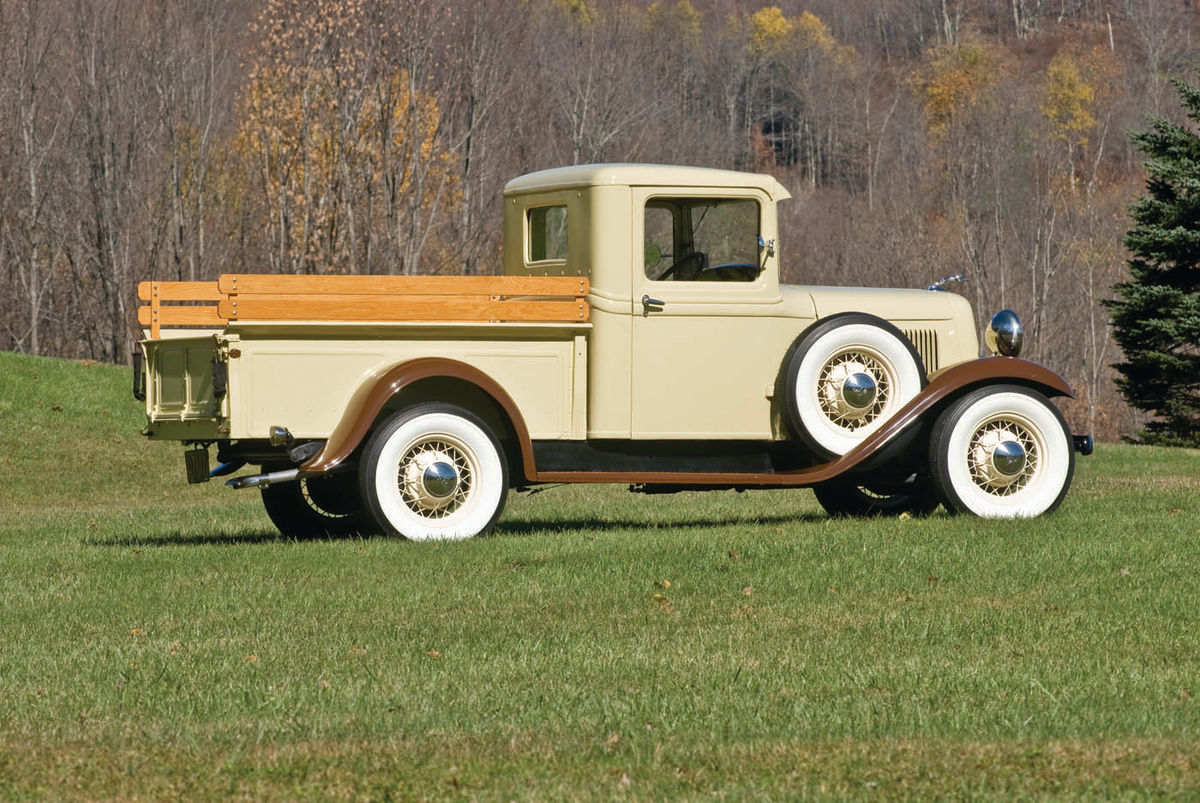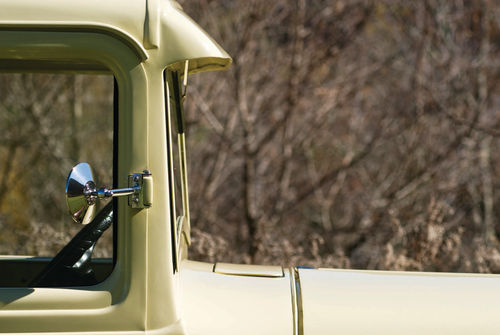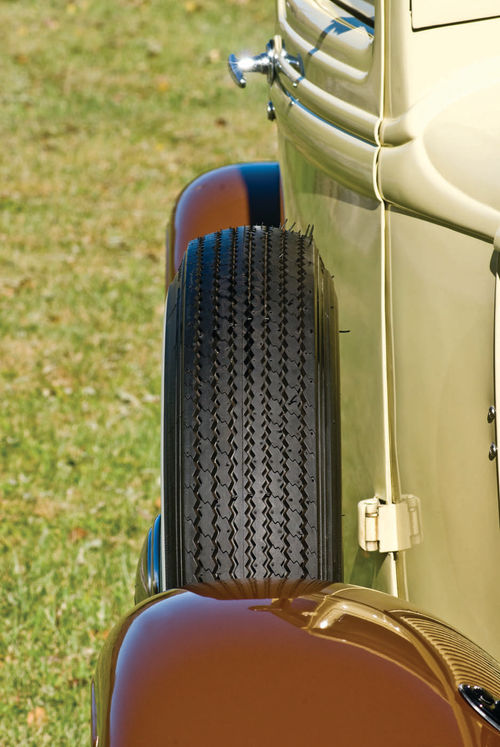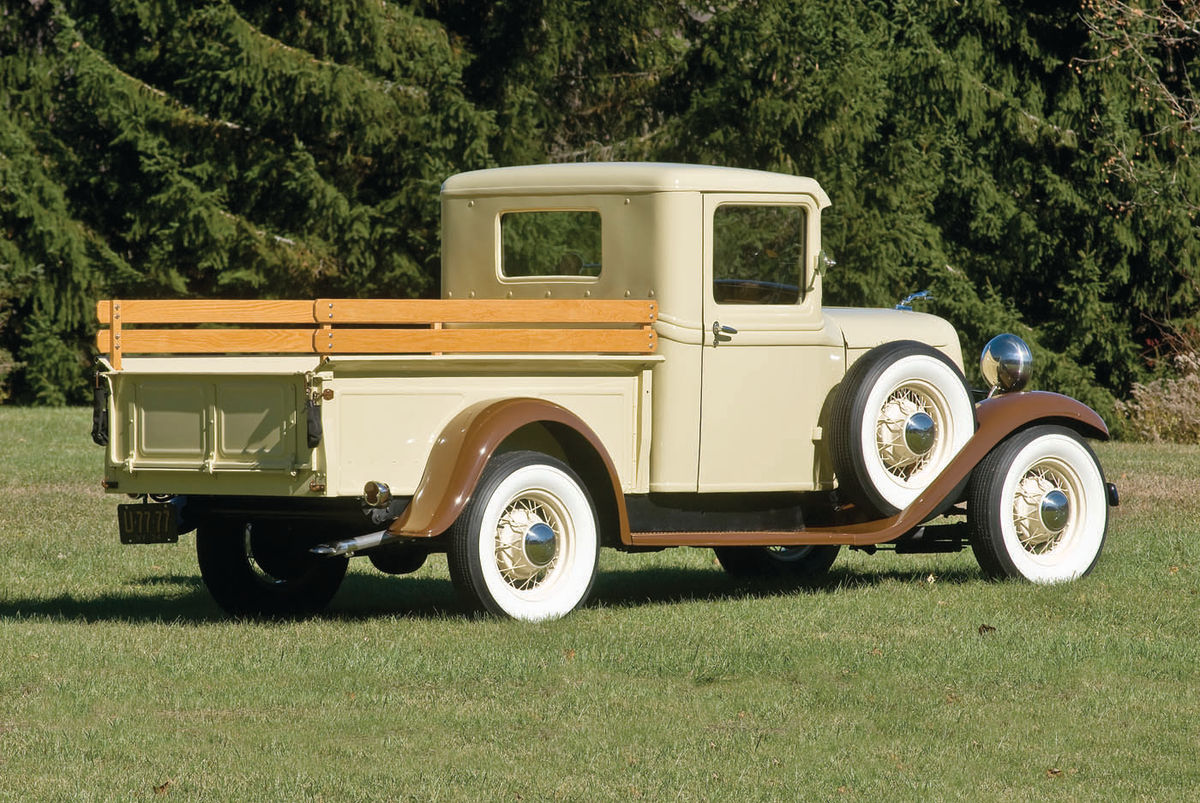1934 Ford Pickup
We’d like it to be a purist’s type of thing,” said Joe Griffin, speaking of his 1934 Ford pickup that’s featured here. “It needs things,” said his son, Jody, “but we’re improving it as we’re using it.” Together, Joe and Jody are in an enviable position. The truck’s needs are far from major and it beckons you to slide behind the wheel and go for a drive. After all, by the time it was built, Fords—and most American vehicles—had become reliable and powerful enough that they can keep up with reasonably paced traffic on today’s roadways. A Ford V-8 such as the one in the feature truck has additional advantages as well, beginning with the fact that “Ford” and “V-8” have seemingly gone together forever in the language of the automotive world. That’s because Ford introduced its first V-8 more than eight decades ago in 1932, and it’s also a result of the company’s ongoing high-profile place in the hobby. With that in mind, it’s a good bet that many folks with only a passing knowledge of collector cars might assume that Ford invented the V-8 or had utilized them since the company’s earliest days. That’s understandable, but wrong.
When the Ford Motor Company was formed, the V-8 was far in the future, as Ford Motor’s first car was the 1903 Model A, a two-cylinder runabout. A four-cylinder followed as the Model B of 1904 and the six-cylinder Model K arrived in 1905. But with other Fords that had been added along the way, all were set aside late in 1908 when the Model T was unveiled. The Model T and its 22-horsepower four- cylinder flathead remained in production through 1927 and the pattern it established would continue exclusively for several more years in the Model A.
Hey, I Coulda Had a V-8...
Ford built its final Model A in 1931 and replaced it for 1932 with two new cars. The freshly styled Model B continued to use the Model A’s 200-cubic-inch flathead four, although its horsepower had jumped from 40 to 50, but the real news came in the Model A’s other replacement...the flathead V-8. Its 221 cubic inches produced 65 horsepower, a significant increase over the four’s numbers.
The new V-8, of course, was a natural for installation in a truck and became available in the light-duty models during 1932. Good for 65 horsepower when it appeared, it was up to 85 horsepower when the Griffins’ truck was built. That might not sound like much, but the Ford V-8 quickly developed a reputation for being fast and maintained that reputation not only throughout its production run, but even to the present day. The fact that it’s supported with speed equipment—in addition to stock components—proves that the reputation is accurate, but so does Joe Griffin’s description of driving the pickup.
“It’s capable of going fast,” he said. “That thing’ll run, but I feel comfortable driving it at 50 miles an hour. Fifty is not pushing it. It seems to be running free and without working it.”
Just to be on the safe side, though, it wasn’t driven home to Walton, New York, after it was purchased in Connecticut in 2014. The truck had been advertised online and Jody said that they’d already looked at a number of other vehicles.
Hauling It Home With Two Trucks
“I had it in my mind,” Joe said, “that I wanted a Model A. I liked the V-8, but I didn’t figure that I could afford one. They bring so much more money than the Model As...but then this one just caught our eye.
“We called the guy and then I took a tractor-trailer load of wood pellets to Danbury, Connecticut. Before leaving I said to the guy ‘is it good enough to drive it home?’ I figured that was a good question to ask. He said ‘yes, if you want to, but you’re going to use up the better part of a day to get there.’
“And it’s hard to drive something like that on the Interstates. You’ve got to have a secondary road.”
That it could have made the trip to Walton is believable, but he had that tractor-trailer and the ton-and-a-half pickup would hardly be noticeable weight on it. There was, however, a problem when it came to getting the Ford onto the trailer since no one seemed to know of any dock that could be used to load it. The solution was a rollback, although not for the actual transportation.
“We put it on the rollback,” Joe explained, “and put the rollback onto the drop-deck trailer and brought it back. It worked fine.”
The Truck Already Had Been Restored
The seller, Joe said, had a small collection and was thinning it in anticipation of a move to Florida. Jody said that the previous owner had restored the truck and that receipts he included date to the early 1990s.

“From what you can tell from these receipts,” he said, “it looks like he started somewhere around ’91with basic stuff and then in 2001, 2002, 2003, it looks like he started doing the serious restoration.”
Regardless of the exact timeline, the work was done and the truck looked good when Jody and his father picked it up. “It was as you see it,” Joe said. “It wasn’t as clean as it is now, but it was pretty much as you see it.”
That explains why he could have driven it home from Connecticut, but even with the completed restoration, there remained additional work and corrections to be made.

The set of headlights that weren’t even similar to the right ones was replaced with a pair that is very close to the original. Like the grille, Jody said, they should be painted, but that’s not as obviously out of place as were those on the Ford when they bought it.
“They were like an aftermarket hot rod (unit),” he said, “six-inch, maybe five-inch. They looked out of proportion.”
“They didn’t fit,” his father stated. “But they probably spent more for them,” Jody said, “than the cost for the right ones.” Were they really that wrong? Apparently they were, judging by the actions taken by a friend.

“It bothered him so much,” Joe said, “that he didn’t even ask us, he just bought them and said ‘here’s some headlights.’”
“He just said ‘they didn’t look right on it,’” Jody added.
The dashboard has similar authenticity problems, but they’ve yet to be corrected. “There are two gauges that were changed,” Joe said. “The speedometer is the original speedometer; the others are aftermarket. I don’t think they’re later
(Ford parts). I think they’re for hot rods.” The temperature and amp gauges serve their purpose, but it’s easy to see that they’re not the ones for the truck and Jody said they will be swapped for those that should be there. The story is about the same under the hood, where the electrical system has been converted to 12-volt and incorrect parts such as hoses, clamps and the fuel pump will be replaced with those that belong on the truck.
Popularity Breeds Parts
“I don’t like them hot-rodded,” Joe said. “I’m somewhat of a purist, but I don’t have to be. I accept what I’ve got. It works. I guess it’s kind of stupid to wonder whether it’s got the right clamp on it, but that makes a difference to me. You know it doesn’t, but it does.”

And that touches on one of the great things about owning and restoring vintage Fords from Model Ts through the flathead V-8 era, namely the fact that nearly every critical—and not-so-critical—part is available. If that’s not enough, it’s difficult to imagine that a Ford of that period could develop a problem that someone else hasn’t already solved. The reason that such statements can be safely made is that those Fords have never really fallen from favor. Model Ts and to a lesser extent Model As are cars that played major roles in getting the antique car hobby started. They also created a market for early speed equipment—think Rajo heads, for example—that then took off in the V-8 years.
Eventually, attention focused on reproduction body panels, a development that probably resulted from the fact that the supply of easily restored or rodded Fords was dwindling. The feature truck apparently never reached the point where it was badly deteriorated, but its body did need some help. Joe said that the only replacements he knows of are the fiberglass rear fenders, which might have been used because the originals were too badly damaged to repair. It is, after all, a truck and its fenders might have taken a beating during its working life. But indications are that it really was a good candidate for a successful restoration project.
“The cab corners,” Jody said, “you don’t see where they were filled over or welded in. It looks like it was probably a pretty sound truck to start with.”
“If you look under the bottoms of the doors—and we had a cover off yesterday trying to fix the latch—you run your hand through the inside and there’s nothing,” Joe said. “It’s not been rusted.”
“And I was feeling around in the bottom for pieces,” Jody added. “It had to have been a southern vehicle to start with.”

The wood in at least the back of the cab has been replaced, Joe said, and the glass and moldings are new. With that level of attention paid to even the small parts—backed up by receipts—a comparable mechanical condition was a logical assumption and essentially the correct one.
However, Joe said that the Ford smoked badly the first time he drove it. That run covered only a few miles and he said the seller had told him that he’d just driven it on a 100-mile trip with no difficulties.
“It was clouds,” Jody recalled. “It was like there was something seriously wrong with it... If you had the windows up it was so bad in there that you couldn’t see in the cab.”
“I was a little nervous that I had a problem,” Joe confessed, “but then found that it was overfilled on oil. We changed the oil in it and that pretty much solved the problem.”
Although the smoking had been enough to raise a concern, it became less serious and then finally stopped completely after father and son put some miles on the truck.
“I drove it to Downsville (New York) to the car show,” Jody said. “Ten miles, but it’s all uphill. Now it doesn’t bother you a bit, so I don’t know whether the rings were stuck.”
“You can go up over Apex Hill now,” Joe said, “and it’ll go over it at 45 or 50 miles an hour.” Apex Hill on Route 268 outside of Walton is a long and fairly steep hill with barely enough level at its base to develop a running start. Joe said that the Ford shows no sign of smoke—either climbing or descending—and explained the elegant secret that helped to get the truck into that condition. “We haven’t done any mechanical work,” he said. “We’ve just used it.”

In 2015, Jody said, that amounted to about 900 miles, down by about 100 miles from the previous year’s total. Aside from taking care of the smoking problem, driving the Ford has shown it to be entirely capable of ascending Apex Hill in third gear and generally at about the 50-miles- per-hour mentioned above.
However, the truck might not have been quite as successful on the hill climbs without the electric fuel pump. “We gave up on the vacuum tank,” Joe said, “and we tried that to help out the vacuum tank. It would die.”
“You could get it so that it would fill the canister up and you’d run it until you’d come to an incline,” Jody said. “It was like it wasn’t pumping enough to keep the level up. It was weak vacuum.”
No Hot-Running Problems Here
Curing its drivability problem was important, since the Ford has too much going for it to be left in the garage. “That will start with no choke,” Jody said. “You can get right in it like I did this morning and never touch the choke. I got in yesterday and the day before and never touched the choke.” “If you do give it any choke,” his father added, “you just make it so that it’ll accept the gas without stalling.”
While it has the typical Ford shifter that can make even an inexperienced driver look good, the clutch requires some careful footwork when starting in either first or reverse. “It’s like you’re in a too-high gear,” Joe explained, “like you should be in a lower gear. Once you get the clutch out and it’s moving, you give it gas and off it goes.
That might sound worse than it is, considering that the Ford has been uneventfully making the rounds to shows within an hour or two of Walton. Joe said that the receipts show the engine and transmission have been rebuilt and by the truck’s performance, he has no reason to doubt that. “It doesn’t feel like it’s old,” Jody agreed. “It’s quiet. It works.” And it does so with the temperature under control.
“We’ve never had any problem with it overheating,” Joe said. “It’s got a new radiator.” “I don’t know exactly what it does run,” Jody added. “I can’t tell you that, but it runs cool even on the hottest days.” That includes hot days on Apex Hill. “The gauge doesn’t even move when
we go up that,” Jody continued. “Once you get it up to running temperature, it doesn’t go up while climbing that hill. It runs in the green; it’s not like it gets over in the red. It doesn’t really move.”
Things to Look For... Things to Be Done
The new radiator, like the fiberglass fenders and the other new parts, are evidence of the support enjoyed by Fords such as the feature truck, but it still pays to start a restoration with the best
one possible. As already noted, chances of finding a decent original example are growing slim not just because of age, but also because so many of those that survived well have already been rescued.
Expect to find rust along the edges of the fenders, in the door bottoms, in the cab floor and cab corners. Rust around the windshield, while not common, is a real possibility and depending on how the truck was used, the box might be anywhere from dented to destroyed. The drivetrains are tough, but a big concern for those who don’t know Fords well is making sure that the engine is correct for the truck, as not all Ford V-8s are identical.
Fortunately for the Griffins, most of the work on the feature truck has been done. “Our next project is under the hood,” Jody said, “the hoses, moving that fuel pump, little things.” “We’ll probably leave (the fuel pump) on there,” Joe explained, “but we’ll just put it up under the cowl or someplace else.
“The only thing we’ll be concentrating on probably is making it run well, using it, doing what we need to do to keep it maintained, I guess. It could use some paintwork, but it’s not going to get done. There are chips here and there.”
“It’s a user,” Jody said. “We use it.”
It’s Staying on the Road
It’s difficult to argue with that “use it” approach. There’s the basic truth as already discussed that it’s reliable overall and when used with common sense, not particularly challenged when dealing with today’s traffic. The Ford’s longest trip from
Walton took it to a show in Carbondale, Pennsylvania, about 60 miles away. That translated to an hour and a half on two- lane roads and the Griffins said it was a comfortable drive.
Add all of the above together and the Ford won’t be moving on to new owners anytime soon.
“We both probably take better care of it than a lot of people would,” Joe said, “but we know what it is to work and earn. There’s no sense in destroying it... But still, we got it to use it. I enjoy just driving it someplace and puffing up.”

The friend who came up with the headlights has suggested that they buy “something different,” Jody said, but that’s not going to happen.
“I can see upgrading to something better,” Jody continued, “but we’re going to look a long time to replace it. It’s something that you can get in and go to Carbondale and not worry about it.”
That’s not completely true. There is worry, but it’s less about the truck than about a problem that often causes delays even on what should be a 10- or 15-minute drive.
A Conversation Piece
“A lot of times, you’re in a hurry and you haven’t got the time to use it,” Joe said. “Because everywhere you go, you’re answering questions.”
“Right,” Jody said, “because everybody has a conversation. It takes an hour to come into town. They’ll say ‘I remember I had one of these when I was a kid.’”















